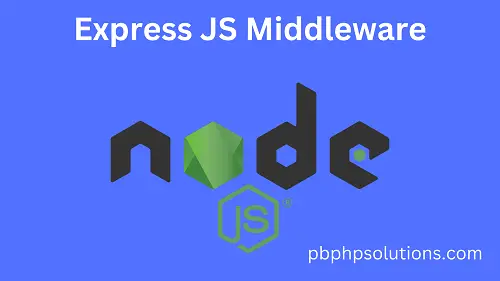Hi friends, In this tutorial I will discuss how to use express js middleware for all routes with an example. So, let us discuss a little bit about middleware.
Also read, How to install Express js in vs code with an example
What is middleware
- Middleware is a function in express js that consists of three parameters: request, response, and next.
Syntex:-
const name_of_middleware = (req, resp, next)=>{
//validate the request if needed
next();
}
- The objective of creating middleware is to accept or handle the request and return the response back to the client.
- It also validates the request and returns the response based on the successful validation and callback to the next() method.
- The middleware will not complete the request and response cycle until the next() method is called.
Example of express js middleware
Step 1:- First, initialize the packages and modules of express js framework with the help of require() method as shown below.
const express = require('express');
Step 2:- Now, get all the features and functionalities of express module and assign it to a variable as shown below.
const data = express();
Step 3:- Now, define the middleware as shown below.
const handleRequest = (req, resp, next)=>{
console.log("tell me something");
if(!req.query.verify)
{
resp.send("Please add the verify parameter");
}
else if(req.query.verify!=="human")
{
resp.send("Verify should be human");
}
else{
next();
}
}
In the above piece of code, you can see that “verify” parameter is added to the request URL that means whenever you access the localhost url, the middleware will validate the request based on the verify parameter. If the validation is successfull then it will call the next() method.
Step 4:- Now, use the above middleware using the data variable of express JS as shown below.
data.use(handleRequest);
Step 5:- Now, declare a route for http request using GET method using the “data” variable which returns the response from the node JS server as shown below.
data.get('/',(req,resp)=>{
resp.send('Welcome to home page');
});
Step 6:- Declare the port as shown below.
data.listen(3001);
Complete Code:-
const express = require('express');
const data = express();
const handleRequest = (req, resp, next)=>{
console.log("tell me something");
if(!req.query.verify)
{
resp.send("Please add the verify parameter");
}
else if(req.query.verify!=="human")
{
resp.send("Verify should be human");
}
else{
next();
}
}
data.use(handleRequest);
data.get('/',(req,resp)=>{
resp.send('Welcome to home page');
});
If you aceess the URL in your browser as http://localhost:3001/ then you will see the output as shown below.
Please add the verify parameter
If you access the URL in your browser as http://localhost:3001/?verify=asdfasf then you can see the output as shown below.
Verify should be human
If you access your URL in your browser as http://localhost:3001/?verify=human then you can see the output as shown below.
Welcome to home page
Conclusion:- I hope this tutorial will help you to understand the concept. If there is any doubt then please leave a comment below. Download VS Code from Here
